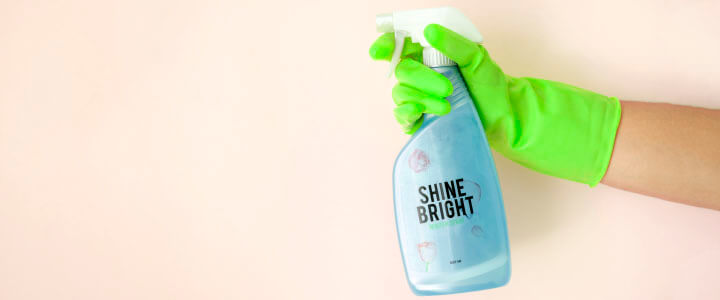Health Effects of Cleaning Products: Toxic Chemicals in Your Home

Cleaning products have raised eyebrows in the market with mounting research pointing to health problems against users. One study with more than 6,000 cohorts carried out over two decades found regular use of cleaning sprays had the same toll on lung health like smoking a pack of cigarettes a day.
The research circulated in the American Thoracic Society’s Journal of Respiratory and Critical Care Medicine warns that inhaling cleaning chemicals over the long haul causes substantial damage to the respiratory system. Chemical compounds contribute to indoor air pollution, are lethal if swallowed, and unleash health hazards to anyone they come into contact with.
Health Effects
Cleaning ingredients pose acute, immediate hazards on asthma or respiratory inflammation, and long-term effects like lung function decline.
Acutely Dangerous Products
Concoctions of certain cleaners can unleash hazardous reactions like the mixture of ammonia and bleach. Mixing them releases venomous fumes that cause coughing, airflow blockage, and irritation of the eyes, nose or throat. Corrosive drain cleaners, oven products and acidic toilet bowl chemicals lead the list of the most acutely lethal cleaning solutions.
Fragrances that give many cleaners their aroma prevalent in laundry detergents or fabric softeners may trigger respiratory itchiness, headache, water eyeballs, and sneezing in hypersensitive individuals suffering from allergy or asthma. The National Institute of Occupational Safety and Health detected toxins in one-third of the substrates used in the fragrance industry. Their makers cloak these ingredients in secrecy.
Long-Term Effects Culprits
Some substrates in cleaners play down acute toxicity but cause long-term or chronic conditions like cancer and hormonal imbalance. Especially all-around workhorses laced with sudsing agents diethanolamine (DEA) or triethanolamine (TEA).
When exposed to nitrites, frequently incorporated as preservatives under trade secrets, they combine to churn nitrosamines-carcinogens that rapidly invade skin cells. 1, 4-dioxane, a carcinogen lurks in cleaner manufactured with ethoxylated alcohols. Some cleaners may also contain Butyl cellosolve, a neurotoxic compound known to destroy brain cells and nervous system.
Chemicals dubbed hormonal disruptors can inhibit the body’s natural chemical transmissions, either by thwarting or simulating biological actions. Potential health defects include low sperm counts, higher rates of male reproductive system disorders like undescended testicles or hypospadias, and increased likelihoods of certain cancers.
The alkylphenol ethoxylates (APEs) common in some cleaners or detergents can simulate the hormone estrogen. P-nonylphenol, an APE has been shown to drive estrogen-sensitive breast cancer into proliferation in a test tube study.
Possible Solutions
Hiring Professionals
Upholstery cleaning Oxford recommends that in order to steer clear of the murky waters of commercial cleaning in the business world, consider a seasoned service provider. In the wake of damning reports regarding cleaning liquids, detergents and agents, specialised service providers with know-how to discern toxic-free products come as a ray of hope.
They respect our planet and capitalise on products safe to nature without health threats. For UK-based businesses, you can hire this eco-friendly cleaning company from London. Employees in such companies have a lot of experience and will deal with your waste in an environmentally friendly way.
If you want to do it personally, then tool up with cost-effective, premium-grade and organic products.
Recipes for Do-It-Yourselfers
A few health-friendly, mild ingredients like soap, vinegar, lemon juice, baking soda, water, and borax, fortified by modicum elbow grease or a grainy sponge for scouring will do the job for household cleaning demands. Soap with water or baking soda for scouring scum and toilet bowls solve most bathroom cleaning needs.
Sprucing up shower tiles with a toothbrush smeared with baking soda cream will wipe out mildew and stains. For onerous toilet chores, mix one cup of borax with ¼ cup of distilled white vinegar or lemon juice in a bowl. Allow it to settle for a few hours before using a toilet brush to scrub and flush. Plant-based bathroom, shower or toilet cleaners also pose no harm.
Organic Deodorisers & Stimulants
To eliminate odours, improve air circulation by opening windows or using fans. Baking soda is a potent deodoriser while spritzes of citrus fruits refresh the air. Wooden cedar chips, pristine essential oils, or packets of organic parched flowers and herbs infuse gentler fragrance.
Abstain from Antibiotics
Overkill antibiotics in agriculture, the widespread use of antibacterial soaps and germ-killing products have spurred increasing mutations in microbial guilds to withstand cleaning agents. People with a vulnerable immune system may resort to these disinfectants but others should avoid them.
Neaten household surfaces with hot, soapy water and elbow grease to nuke microbes. Your culinary hygiene must be hygienic to rule out food-borne pathogens.
Glass Cleaners
Some window cleaners swarm with nerve-injurious butyl cellosolve. A vast majority have ammonia, which causes inflammation along airways and discharges poisonous chloramine gases if inadvertently combined with chlorine-rich cleaners. Plain waters pack a punch as powerful as some brands.
Alternatively, fill a spray bottle with water followed by ¼ cup of white vinegar or 1 tablespoon of lemon juice to get rid of greasy fingertips and stubborn spots.
What to Avoid
Avoid cleaners with “Danger”, “Poison” and glaring warnings such as corrosive. Shun products with chlorine, ammonia, phosphates, misleading labels, and all-purpose or enzyme cleaners with toxic surfactants, chemicals or preservatives. Chemical drain cleaners top the charts of the most lethal products. Consider chemical drain cleaners with enzymes rather than caustic chemicals to dissolve gunk.


















